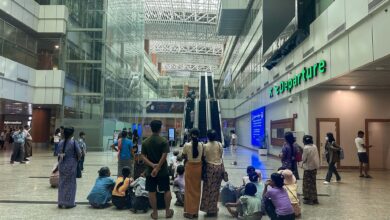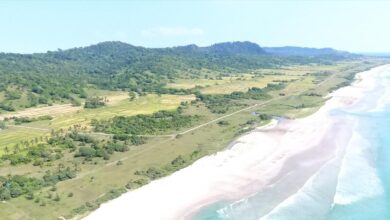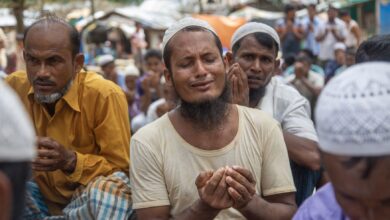
On a hot morning six days after the February 1 coup, huge crowds converged on Hledan junction, a major focal point of protests in Yangon, holding anti-dictatorship signboards, photos of Aung San Suu Kyi, and flags of her party, the National League for Democracy (NLD).
Thousands marched towards the junction from all directions, filling roads and lanes.
That same morning, thousands of women from the factories of the industrial suburb of Hlaing Tharyar joined a march led by Ei Thinzar Maung, the youth chair of the Democratic Party for a New Society (DPNS) and a prominent figure during protests related to the National Education Law back in 2015.
Scenes of the female workers’ march in Yangon went viral on social media. Praise for the women inspired many others to take to the streets in protest as well.
The day before the protest, Ei Thinzar Maung denounced the “so-called democratic reform led by the military” on her Facebook page and warned that the citizens of Myanmar would have to “endure the worst outcomes of this coup.”
She continued: “It is up to us, as well, to fight against this. We must put an end to this political mindset that we’ll endure everything the military does. Now is the time for us to form a new political approach with the real forces of the people.”
As the women marched from Hlaing Tharyar, leaderless protests from all directions gathered at Hledan junction, shouting “We don’t want dictatorship” in unison. A few hours later, at around 11am, the junta cut off the internet.
Although social media users initially campaigned for large-scale protests to begin on February 7, following days of smaller demonstrations scattered around the country, they actually began a day earlier, and have continued unabated ever since.

Locking up the leaders
The military, led by Commander-in-Chief Senior General Min Aung Hlaing, set these events in motion less than a week earlier when it carried out pre-dawn raids to arrest incumbent government leaders on February 1 and seized power.
Elected candidates in the 2020 election were to be sworn in later that day. But at around 2am, government leaders, including State Counsellor Aung San Suu Kyi and President Win Myint, were detained by the military.
During the raids, hundreds of elected candidates and other well-known political figures were also arrested.
According to the senior general, the military was obliged to take control because officials from the Union Election Commission (UEC) had failed to address concerns about alleged voter list inaccuracies. The move was in line with the requests of the losing parties, he said.
“The political parties asked for help from the military, which is involved in leading the nation. The military asked the UEC, the parliament and the president to check the voter lists and they failed to fulfil their responsibility. The military tried to, until the very last moment, coordinate under the law and find a solution. But the officials failed to do their duty and lacked responsibility, giving various excuses,” Min Aung Hlaing said on February 8 in his first televised post-coup speech.
Having detained President Win Myint, the military made its vice-presidential pick, Myint Swe, the interim president so that he could call on the military to assume power under a state of emergency, in line with provisions in the 2008 constitution.
Under section 417 of the constitution—which was drafted by the military and ratified after a rigged referendum held in the wake of Cyclone Nargis in May 2008—only the president can declare a state of emergency.
Meanwhile, the “Chair NLD” Facebook page—a party-affiliated page with over 1.5 million followers set up for the use of Aung San Suu Kyi—posted a statement at around 11am on February 1 declaring the coup “unconstitutional”.
“The military’s act was not only inconsiderate of the majority of the nation living through a global pandemic but also a deliberate act to put the country under a dictatorship,” the statement read.
“Therefore, we urge the people to refuse and completely defy the coup. The people come first,” it continued.

Spreading resistance
In Japan, hundreds of Myanmar citizens wasted no time answering the call, gathering outside the UN office in Tokyo to demand the release of the detained politicians and voice their condemnation of the coup.
At the same time, well-known political figures such as Min Ko Naing and Jimmy used their Facebook pages to urge the people to protest against the dictatorship.
On February 2, a day after the coup, the junta formed the 11-member State Administrative Council to assume power over the country.
This triggered the first open displays of public anger at the coup. At around 8pm that night, people started to bang pots and pans in their homes nationwide as an act of defiance.
Based on the custom of creating a clamour to ward off evil spirits, this pot-banging campaign became the most popular way for ordinary citizens to register their extreme displeasure at the return to military rule after a decade of relative political freedom.
As the days passed, more and more Myanmar citizens living abroad flocked to Myanmar embassies to protest, drawing international attention to the crisis in their homeland.
Min Ko Naing and Jimmy, both veterans of the 1988 uprising, now called on civil servants to stop going to work to disrupt the junta’s control over the mechanisms of the state and urged other citizens to boycott the products of military-owned conglomerates.
Five days after the coup, a nascent resistance movement coalesced into nationwide uprising that included not only the major cities of Yangon, Mandalay, and Naypyitaw, but also smaller centres around the country.
Key to this effort to oust the regime is the civil disobedience movement (CDM), which started with healthcare workers and steadily widened to include public employees working in a number of different ministries. “Don’t go to the office, get out of the system” soon became a mantra of the movement.
Millions of others have also responded to calls to resist, joining massive protests to fight for the future of democracy.

Echoes of ‘88
Htat Htar Myint, who runs an umbrella business in Pazundaung, joined the protests on February 8. She said she has despised the dictatorship ever since the coup of 1988.
The main difference between the uprising then and the current situation, she said, is that this time, young people are taking the lead, and now they have the advantage of social media.
“Now that there’s social media, they [the military] can’t do whatever they want. We are constantly connected to the rest of the world now. In ‘88, they did whatever they liked. Now, it’s a different era,” said Htat Htar Myint, who is now in her fifties.
Knowing that they are living through an historic moment, many of the protesters have allowed their children to join them in the streets. Even pregnant women and mothers with babies strapped to their backs have been seen joining in the marches.
Increasingly, the protests have taken on a life of their own. Not led by any group or individual, they have brought together people from every walk of life, all motivated by the same desire to defend their basic freedoms and guarantee a better future for themselves and their children.
Aung Kyaw Kyaw, a 21-year-old teacher at an Islamic school, vowed to continue fighting for as long as necessary.
“This is our future at risk. I don’t want to be a slave under these illiterates,” he said.
Others scoffed at the idea that the military seized power for the sake of the country.
“This isn’t the people’s wish. The military is doing this because it’s what they want,” said Kyaw Kyaw, a Myanmar Railways worker in his 30s, during a protest on February 9.
“We don’t agree with it. We don’t support it. We condemn it. We refuse it. So we’re asking for our elected government back,” he said.
But even as they steel themselves for a long struggle, many fear what the regime may do to stay in power. The constant threat of violence, which has already claimed a number of casualties, has so far done little to deter huge turnouts at mass rallies. But brute force isn’t the only weapon the regime has at its disposal.
Perhaps recalling the demonetization that devastated so many in 1988, some residents of Myanmar’s major cities went on a spending spree soon after the coup amid rumours that 5,000- and 10,000-kyat notes would be taken out of circulation.
Many withdrew their savings from banks, and gold—a popular hedge against inflation—became scarce as some shops began running out. Like the regime’s promise that it will restore civilian rule in a year’s time, after fresh elections, the reassurances of central bank officials have fallen on deaf ears.
For most, the only real security will come when Myanmar has finally shed the legacy of decades of arbitrary military rule. And having witnessed the collapse of a military-engineered “democratic transition” to civilian rule, it is now impossible for anyone to believe the generals can be trusted to yield to the will of the people.
The only hope now, then, is that popular opposition to their rule will ultimately prevail. And so the struggle continues.



